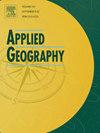Geographic constraints on rapid comprehension of tornado warning information
IF 4
2区 地球科学
Q1 GEOGRAPHY
引用次数: 0
Abstract
Sketch-mapping activities with in-person interviews were conducted with 65 participants in Alabama and Mississippi to explore how geographic awareness impacts risk perception for tornadoes. Geographic awareness metrics represented three variables: 1) the distance between their perceived home location and actual home location (P-A) on a blank map, 2) the correct percentage of counties (POC) labeled that bordered their home county, and 3) an assessment of the accuracy of their county shape (SHP) from their drawing. Results showed that participants who are more competent in one area of geographic awareness will also have some competency in the other measures. Accurate knowledge of tornado path direction was statistically significant with P-A distance, POC, SHP, and number of roads drawn. The demographic characteristics of participants and their geographic awareness scores were used with Principal Components Analysis and Cluster Analysis to detect which traits of participants were associated with better geographic awareness. Four distinct groups were identified with two groups having low or poor geographic awareness. The traits associated with these groups are nuanced. Of the four groups, the lowest ranking poor local geography group was characterized by the highest rate of home ownership, and was ranked second oldest, second in time lived in the county, and second in education, with higher racial and ethnic diversity than two groups. This suggests that experience, age, and education do not necessarily translate into knowing geographic information about the county or city. People with low geographic awareness are at a disadvantage when making protective action decisions during tornado warnings. More research is needed to examine the robustness of these results to determine best strategies for communicating information.
地理限制对龙卷风预警信息的快速理解
在阿拉巴马州和密西西比州对65名参与者进行了面对面的访谈,以探索地理意识如何影响龙卷风的风险感知。地理意识指标代表三个变量:1)他们在空白地图上感知到的家乡位置与实际家乡位置之间的距离(P-A), 2)与他们的家乡县接壤的县的正确百分比(POC),以及3)从他们的绘图中评估他们的县形状(SHP)的准确性。结果表明,在地理意识的一个领域更有能力的参与者在其他方面也有一定的能力。对龙卷风路径方向的准确认识与P-A距离、POC、SHP和绘制的道路数量有统计学意义。采用主成分分析和聚类分析方法,对被试的人口统计学特征及其地理意识得分进行分析,以确定哪些特征与地理意识的提高有关。四个不同的群体被确定为两个群体具有低或差的地理意识。与这些群体相关的特征是微妙的。在这四个群体中,排名最低的贫困本地地理群体的特点是住房自有率最高,年龄排名第二,在该县居住的时间排名第二,受教育程度排名第二,种族和民族多样性高于其他两个群体。这表明,经验、年龄和教育程度并不一定转化为了解县市的地理信息。在龙卷风警报期间,地理意识较低的人在做出保护行动决定时处于不利地位。需要更多的研究来检验这些结果的稳健性,以确定沟通信息的最佳策略。
本文章由计算机程序翻译,如有差异,请以英文原文为准。
求助全文
约1分钟内获得全文
求助全文
来源期刊

Applied Geography
GEOGRAPHY-
CiteScore
8.00
自引率
2.00%
发文量
134
期刊介绍:
Applied Geography is a journal devoted to the publication of research which utilizes geographic approaches (human, physical, nature-society and GIScience) to resolve human problems that have a spatial dimension. These problems may be related to the assessment, management and allocation of the world physical and/or human resources. The underlying rationale of the journal is that only through a clear understanding of the relevant societal, physical, and coupled natural-humans systems can we resolve such problems. Papers are invited on any theme involving the application of geographical theory and methodology in the resolution of human problems.
 求助内容:
求助内容: 应助结果提醒方式:
应助结果提醒方式:


